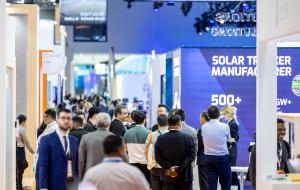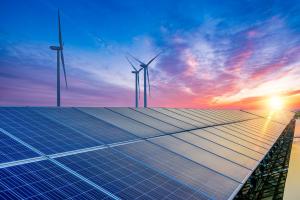
Clean Energy & Solar Conference at World Future Energy Summit 2025 to Accelerate MENA Renewables Transition
The event’s solar exhibition, the largest of the six verticals, will host over 100 exhibitors in January, covering innovative product categories such as energy storage technologies, photovoltaic cells and modules, rooftop solar PV systems, utility-scale PV systems, as well as hosting several regional and international trade and industry associations, government regulators, and utility companies.
As countries across the region progress an assortment of renewable energy agendas, the conference and large-scale exhibition vertical will bring together a powerhouse gathering of industry experts, innovators, and investors to explore the latest developments, strategies, and innovations shaping the clean energy and solar sector.
Pivotally, the Clean Energy & Solar Conference, which will run on January 14-16, 2025, arrives as many regional government’s long-term energy commitments – linked to wider national development and economic diversification initiatives – come into focus five years ahead of 2030 expiry dates.
At the tip of the renewables spear, GCC member states boast some of the world’s highest solar exposures with their geographical position in the heart of the global sunbelt, making Gulf countries an ideal global hub for solar energy development. ScienceDirect estimated that GCC countries plan to add an estimated 66 gigawatts (GW) of utility-scale renewable energy by 2030, driven by a pressing need to transition from fossil fuels.
According to a new report from the International Energy Agency, the combined objective of MENA countries is to reach 201 GW of renewable capacity by 2030. While the main-case forecast falls 26 per cent short of the 2030 target, not all countries will miss their announced ambitions. Saudi Arabia, Egypt, and Algeria are responsible for nearly 60 per cent of the region’s total renewable energy mix, but are currently tracking short on installed capacity ambitions. The UAE, Oman, and Morocco, meanwhile, are all expected to exceed end-of-decade targets.
Across the Middle East, multi-billion-dollar investments are making an unprecedented pipeline of major upcoming solar, wind and hydrogen production facilities. While the UAE and Saudi Arabia lead, the breadth and ambition of projects should be seen as a regional commitment to clean energy. In terms of investment, the largest is Noor Energy 1, a US$4.3 billion project, managed by Dubai Electricity and Water Authority, that will include the world’s tallest solar tower (260 metres), making it one of the most advanced mixed solar technology projects in the world. Saudi Arabia is investing US$1.5 billion in its Red Sea Solar Project, which will provide power to the Red Sea Development, which has a 100 per cent renewable energy target and is part of the Kingdom’s broader push for sustainable tourism.
“This conference comes at a crucial time as regional players pursue ambitious renewable energy targets by 2030,” said Hinde Liepmannsohn, Executive Director of MESIA who are releasing their Solar Outlook Report 2025 at the Summit. “Saudi Arabia is aiming to generate 50 per cent of its electricity from renewables, the UAE plans to triple its renewables contribution, Oman is targeting the generation of 30 per cent of its electricity from renewables, and Qatar intends to boost the share of renewables in its power mix from five per cent to 18 per cent.
“We have been producing this report for more than 10 years, and readers can expect comprehensive data and insights that provide a thorough overview of the latest updates across the region. In addition to covering more than 14 countries, it also features the expertise of our members and partners on crucial topics impacting the growth of solar, including technology and financing.”
The conference also follows recent UAE initiatives to enhance its renewable energy landscape, which will be highlighted at the Summit. The UAE’s Ministry of Energy & Infrastructure (MOEI) and Etihad Water and Electricity (EtihadWE) have partnered on a project to install rooftop solar panels in the Northern Emirates, enabling homes, businesses, and farms to contribute to the country's renewable energy supply.
Simultaneously, MOEI has also partnered with Siemens Energy to integrate cutting-edge solutions into the nation’s energy sector, while Masdar, the Summit's host, is expanding its renewables portfolio through acquisitions, including the recent purchase of Saeta Yield’s assets, by adding 745 MW of wind energy and 1.6 GW of solar projects in Spain and Portugal.
The conference features a compelling agenda with panel discussions, keynotes, and fireside talks on crucial topics such as energy transition investment; grid optimisation for energy transition; net-zero pathways; long-duration energy storage; the rise of green hydrogen and future hydrogen markets; AI in energy planning and management, and carbon removal technologies. Notable speakers include Yasin Kasirga, Decarbonisation Leader - Middle East & Africa at GE Vernova, and Dr Mohammad Abu Zahra, Head of Middle East and Africa at the Global Carbon Capture and Storage (CSS) Institute, who will discuss the role of carbon removal technologies in energy transition models.
“In the CCS domain, we see the Gulf region as a major emerging market,” said Abu Zahra. “The GCC states all offer excellent geological storage capacity, gas separation knowledge, and strong governmental commitments. As the world accelerates toward net-zero goals, carbon removal technologies will play a critical role in reshaping the energy landscape and driving meaningful climate action.”
With over 400 global companies anticipated to participate, the 2025 Summit serves as a vital B2B platform for the clean energy sector, aligning with the UAE's Energy Strategy 2050 to target investments of up to AED200 billion by 2030 to meet growing energy demands.
“Exhibitors will have the unique opportunity to network and form partnerships with industry specialists as the sector works collectively toward a common goal of a sustainable energy future,” said Leen AlSebai, General Manager of RX Middle East and Head of the World Future Energy Summit.
The Clean Energy & Solar Conference is one of seven dedicated knowledge exchange streams at the Summit, with each offering in-depth discussions on themes ranging from AI in sustainability to initiatives supporting women in energy. With its holistic approach to clean energy dialogues, the conference agendas aim to drive actionable strategies for a sustainable future.
Nour Ibrahim
MCS Action FZ LLC
+971 544250187
email us here
Distribution channels: Business & Economy, Companies, Conferences & Trade Fairs, Energy Industry, Environment
Legal Disclaimer:
EIN Presswire provides this news content "as is" without warranty of any kind. We do not accept any responsibility or liability for the accuracy, content, images, videos, licenses, completeness, legality, or reliability of the information contained in this article. If you have any complaints or copyright issues related to this article, kindly contact the author above.
Submit your press release


